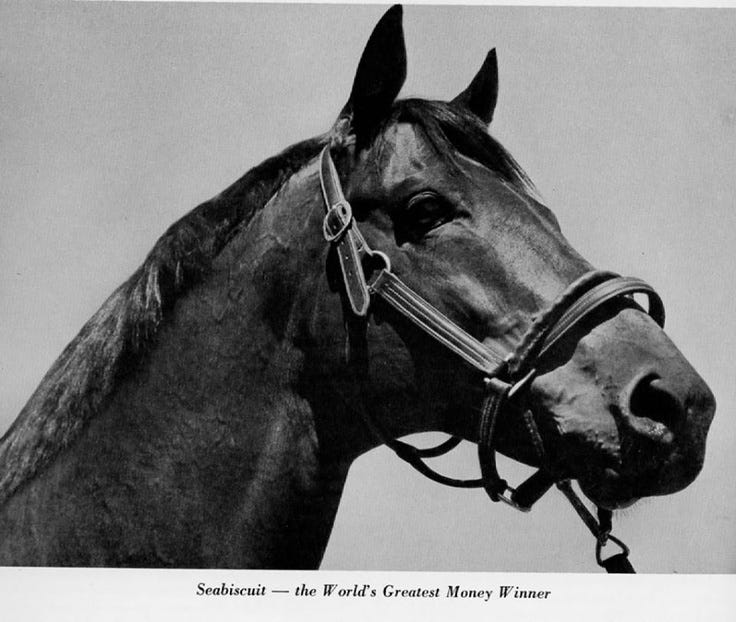Seabiscuit Writers
Writing
By all accounts, Seabiscuit was a butthead of a horse early in his life and was given up on by numerous people. One of his earliest trainers, James Fitzsimmons, was noted as saying, “I found out why he wasn’t running. It wasn’t that he couldn’t. It was that he wouldn’t. He was lazy. Dead lazy.” As a result of numerous people losing hope in him and his, Seabiscuit started pushing back against any trainer or rider that tried to work with him.
That was all until a gentleman named Tom Smith came into the picture. Smith first saw Seabiscuit at Suffolk Downs in Boston in 1936. Of their first encounter, Smith said, “He looked right down his nose at me, “like he was saying, ‘Who the devil are you?’” However, Smith was a bit of a horse whisperer, so he was up for the challenge. When he was asked to work with Seabiscuit, Smith went into the discouraged horse’s stall, closed the gate, sat on the ground, and simply watched Seabiscuit for hours. He noticed the horse wasn’t eating and would just pace around the stall agitated. Former Jockey Trainer, Kris Goddard, revealed, “Smith realized that Seabiscuit needed to run for the joy of it, not because he was being whacked 46 times as he was running down the stretch.”
I won’t tell the whole story of Seabiscuit, but both the horse and trainer made me think of teaching, specifically teaching writing. Many writers—including myself, many of you, and, if you’re a teacher, your students—are Seabiscuit. They are writers who are agitated, pushing back, full of insecurity, and, ultimately, not living up to their full potential. I have been the student who turned in last minute, sloppy papers, and I have been the student who half assed many papers simply for the sake of getting them done. I have also been the teacher who collects and grades mediocre writing from writers who, for a plethora of reasons, are full of untapped potential—Seabiscuit writers. Seabiscuit writers are created over many school years by us, teachers. They are writers who don’t give you their best because a former teacher told them they couldn’t write. Writers who don’t give you their best because they were never given feedback beyond “AWK” or “Needs revision.” Writers who don’t give you their best because they have never been recognized or validated as writers.
Seabiscuit writers are often created by their experiences with writing teachers and writing classrooms. This means, however, they can also be transformed by their experiences with writing teachers and writing classrooms. Unfortunately though, there are not a lot of Tom Smiths out there. There aren’t teachers out there who are willing or able to slow down, sit back, and study their insecure writers to figure out how to support them. Instead, there are a lot of prescriptive teachers who assign writing instruction rather than teach it. They “whack” students into writing.
Your essay should only have five paragraphs [whack]
Each paragraph should only have five sentences [whack]
Make sure to you have a thesis sentence in your first paragraph [whack]
Don’t use “I” in your writing [whack]
Make sure to signal your conclusion [whack]
This is awkward. Reword [whack]
Never start a sentence with a conjunction [whack]
For Seabiscuit, the never-ending whacking stole his attention from the joys of running. He lost sight of how good it felt to stretch his legs out, the wind blowing through his mane, the blood coursing through his veins, and the fresh air he breathed in through his large nostrils. The whacks didn’t allow him to feel the joy of running, so he quit running.
Our young writers are experiencing something similar and are, justifiably, reacting the same. Rather than allowing our students to recognize the joys of writing—telling a story well, being published, writing for an authentic audience, receiving genuine feedback, learning what they are doing well, developing their voice, recognizing the rhythm in which they write—we are “whacking” them so often it forces our young writers to fix their gaze behind them at the whip rather than in front of them at the vast space in front of them full of opportunity.
If Seabiscuit never met Tom Smith, he would not have lived up to his full potential and become the champion racehorse he became. A horse that has inspired and continues to inspire people all over the world.
I write this as a reminder to all writing instructors, myself included, that students come to us with enormous potential. Let’s strive to slow down and study each one of them so we learn what each needs rather than blanket them all with “whacks.”






My younger daughter just received comments on a paper for a dual enrollment course - 3 whacks!
"The context should be one sentence, not three." "Never use the phrase 'This quote shows..."' again." "89/100" Needless to say, the teacher is no Tom Smith.
I hope you consider taking this piece further.
Wow! Excellent article! I’m teaching narrative writing this week so this is a great reminder to take my time and ensure my students enjoy the writing process!